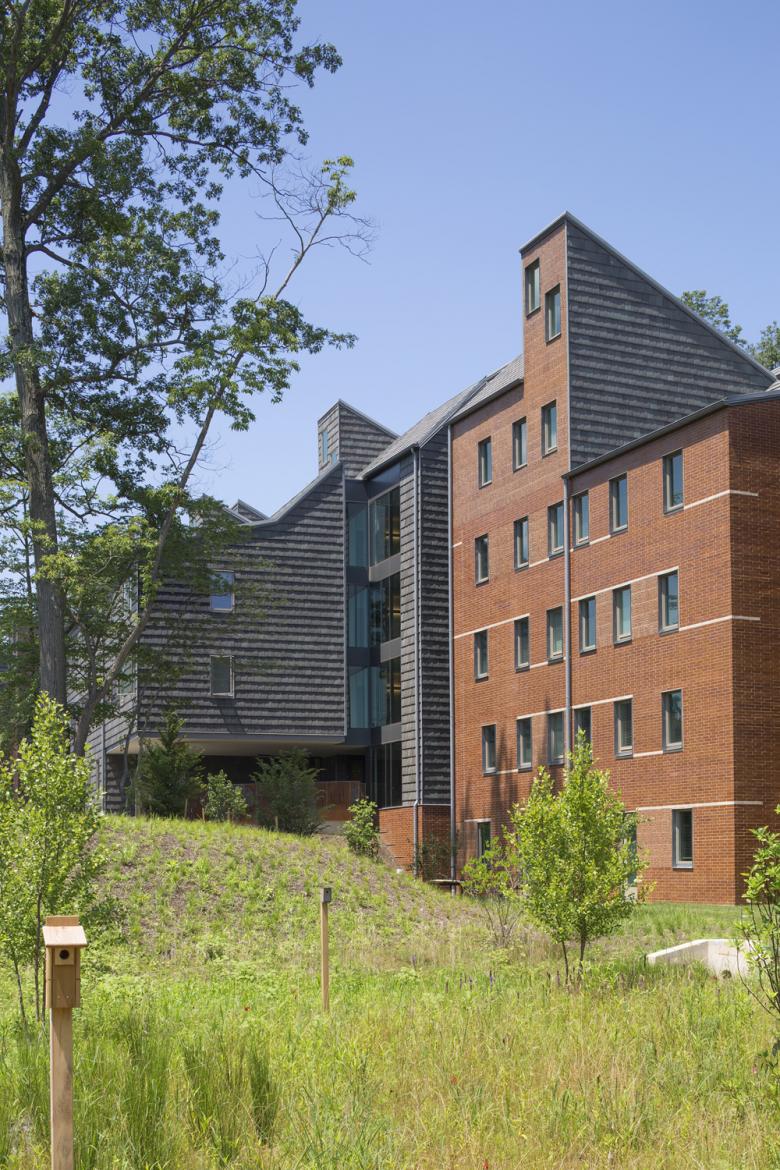Lakeside Graduate Student Community
19. September 2016
Princeton University's campus consists of nearly 200 buildings spread across 500 acres. This footprint and large building stock led the school to impose a voluntary carbon tax, which affects the design of new buildings. Accordingly, Studio Ma's design of dorms and townhouses for graduate students at the southern tip of campus (not far from Princeton's own large solar farm) provides a number of sustainable features in the brick and wood buildings. The architects answered a few questions about the project.
Please provide an overview of the project.
Princeton’s Lakeside Graduate Student Community provides 715 beds through a combination of townhome and mid-rise apartments, commons facilities and a wrapped parking structure on a 16-acre site on the main campus. The project is designed to foster a cohesive campus graduate student community. Lakeside extends Princeton's campus fabric, anticipating its future growth and expansion across Lake Carnegie.
The site is located in the southwestern section of the main Princeton campus, within a 10-minute walk from its core academic facilities. It is bordered by Lake Carnegie to the south, the New Jersey Transit “Dinky” tracks to the west, a campus roadway to the north, and a protected stream to the east. Two 1960’s era concrete housing blocks have been fully remediated and demolished while extensive native forest areas remain and continue to be protected throughout construction.
Buildings are placed on existing parking lots to maintain the old growth forest while reducing impermeable surfaces on site. Wooded areas, meadows and rain gardens between buildings help manage on-site storm water and improve the quality of runoff into the adjacent stream and lake. The team also worked with Princeton Township to keep streets narrow, like those on campus, to encourage slow vehicular speeds on the site. An extensive network of pedestrian pathways weaves through the community, connecting the buildings to each other and to the main campus to the north and east. A 504-car parking deck is located near one of the vehicular entrances, concealed from view by a wrapped layer of town homes.
What are the main ideas and inspirations influencing the design of the building?
The design takes its cues from Princeton University's precedence of "form following topography." Respecting Princeton's historic neo-gothic architectural history within modernist sensibilities, the following principles informed Studio Ma's design solution:
- linear layering
- stepping masses
- roofscapes
- landscape/vertical articulation
How does the design respond to the unique qualities of the site?
The site plan orients the mid-rise buildings along view corridors that also coincide with the optimal solar orientation. Building masses are lean, tall, and vertically articulated, and follow Princeton Campus Gothic precedents by stepping down the site contours. Layered massing and folded roofscapes also take cues from Gothic precedents and are enhanced by terracotta tile cladding and brick patterning to bring texture, detail and scale to the project.
How did the project change between the initial design stage and the completion of the building?
The program for the project was developed through extensive research of Princeton’s graduate community, the primary users of the facility. Princeton had assumed that the large majority of the units would be studios and one bedrooms. However, after a series of surveys and focus groups it was found that the graduate community was made up of a range of groups, each with their own living needs and preferences. It was also found that the community changed over time, with the younger students expressing a strong preference for the relatively-low cost, communal option offered by larger two and three bedroom units. The privacy and individual amenities offered by studios and one bedroom units became more important with more established students and couples. Town home and midrise building typologies provide additional lifestyle options for the community while enhancing the human scale of the building in the landscape.
Site Plan
Was the project influenced by any trends in energy-conservation, construction, or design?
Lakeside’s siting, geo-exchange mechanical system and material choices contribute to an EUI (energy use intensity) of 28, exceeding Architecture 2030’s target reductions in energy use. A life-cycle cost analysis was performed to determine HVAC options, considering not just initial cost, but also the annual operating expenses and environmental costs, the latter of which is determined with Princeton’s self-imposed “carbon tax” of $35 per metric ton of carbon dioxide. The options under consideration had similar life-cycle costs—until the carbon tax was factored in. The result tipped the decision to the ground-source system. Additional sustainable features include the reuse of felled wood on this site for interior paneling at building lobbies, improved thermal envelopes, potable water use reduction as well as Energy Star lighting and appliances. The mid-rise buildings are designed to LEED for Homes Silver and LEED for Homes Gold for the townhomes.
Email interview conducted by John Hill.
Site Section
Diagram: Layering
Diagram: Stepping
Diagram: Landscape
Diagram: Roofscapes
Lakeside Graduate Student Community
2015Princeton, New Jersey
Client
Princeton University
Architect
Studio Ma
Princeton, NJ
Design Principals
Christiana Moss, Christopher Alt, Dan Hoffman
Project Architect
Christopher Alt
Project Manager
Timothy Keil
Project Team
Christiana Moss, Christopher Alt, Dan Hoffman, Timothy Keil, Kelly Vanyo, Brad Pfahler, Mark Lewis
Structural Engineer
SCA
MEP/FP Engineer
Dagher Engineering
Landscape Architect
Hoehn Landscape Architecture
Lighting Designer
Roger Smith Lighting Design
Interior Designer
Studio Ma with Sixth River Architects
Contractor
CCJV
Construction Manager
Hunter Roberts
Owner's Agent
American Campus Communities
Brick
Endicott Brick (ironspot smooth and artisan brick)
Clay Tiles
Ludowici Clay Tile
Site Area
16 acres
Building Area
384,000 sf (550,000 sf with parking structure)
Photographs
Matt Wargo Photography
Drawings
Studio Ma
Verwandte Artikel
-
Spotlight on Italy
16.05.18
-
Bologna Shoah Memorial
20.07.15










